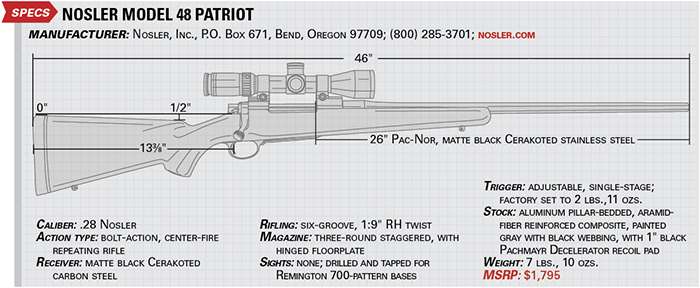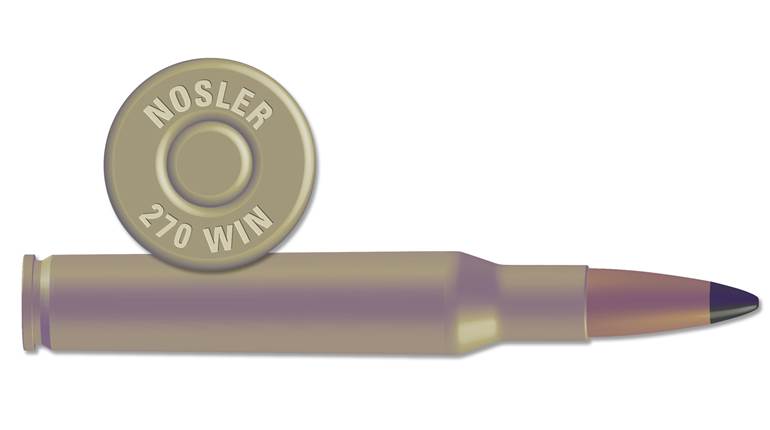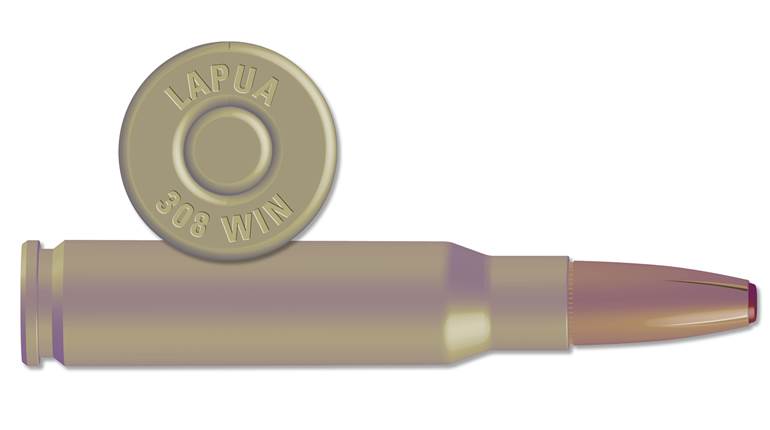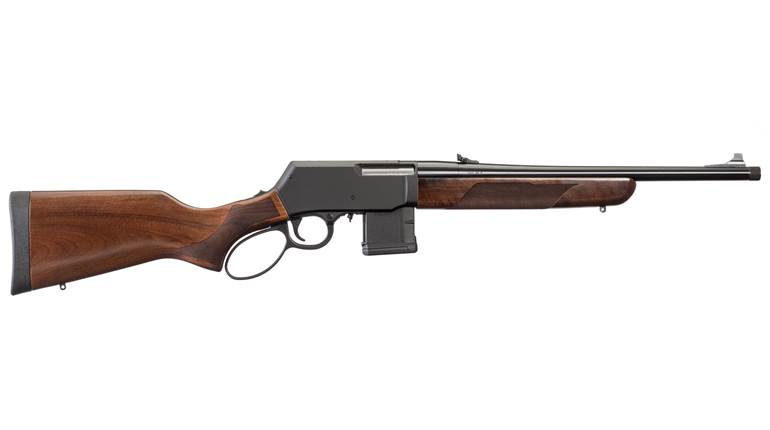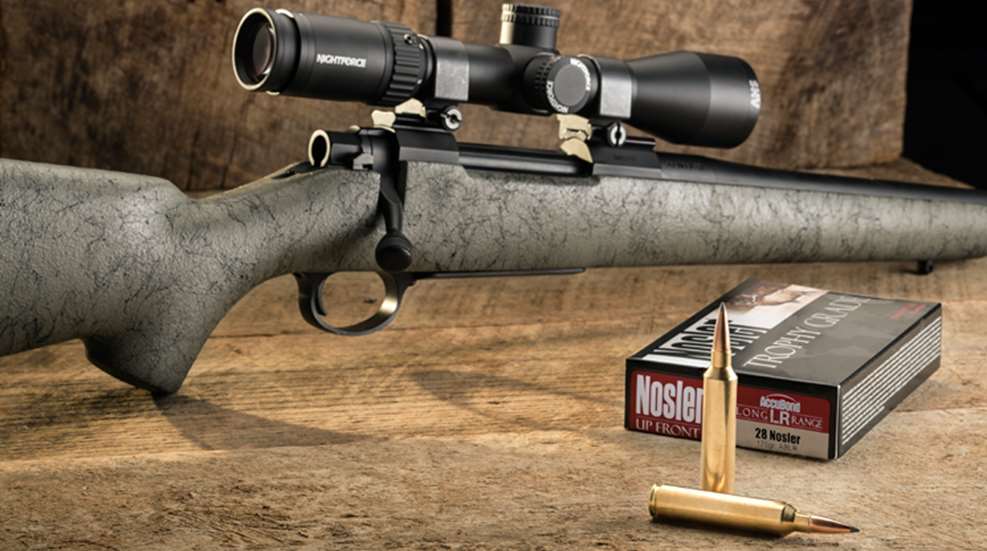
Topped with a 3-10X 40 mm Nightforce SHV riflescope, a Nosler Model 48 Patriot rifle chambered in .28 Nosler is capable of taking most of the world’s big game—with real long-range advantages in trajectory and wind drift when compared to others using .30-cal. magnum cartridges and bullets of similar weight.
The obvious question after the .26 Nosler appeared in 2013 was: “What will the company neck it to next?” The best guesses were a 7 mm or a .30-cal., and the former turned out to be right. Of course, as soon as Nosler announced the .28 many asked, “Why bother?” since the list of 7 mm big-game rounds compares to the Fortune 500. Such skepticism is apparently a normal reaction in the Internet age, when shooters all over the world can anonymously demonstrate their affected sophistication. Meanwhile, some of us retain a little innate curiosity.
One obvious reason for the .28 Nosler would be the success of the .26 Nosler (December 2014, p. 46). Despite predictions from such sophisticates, enough hunters bought .26s to cause a year-long shortage in Nosler 6.5 mm bullets. They found the .26 did what Nosler claimed, shooting high-ballistic-coefficient 6.5 mm bullets accurately at very high velocities, making hitting at longer range easier due to less bullet drop and wind drift.

It also turns out that barrels on .26 Nosler rifles last longer than some skeptics predicted, most shooting accurately for at least 1,000 rounds. One customer who contacted Nosler even said his still shot well after 1,600. Necking the .26 to 7 mm will increase barrel life somewhat, and provide the same high-performance zip with heavier bullets.
Like the .26, the .28 Nosler also fits in a .30-’06 Sprg.-length magazine, providing a couple of advantages. The propellant capacity (and hence velocity potential) of the .28 Nosler is very close to that of the 7 mm STW (May 2013, p. 84), but not all actions can handle the STW, while the .28 will work in any action with a magazine long enough for the 7 mm Rem. Mag. or .300 Win. Mag. And the dimensions of the Nosler case also allow any 7 mm Rem. Mag. to be rechambered. At the other end, any action with a somewhat longer magazine, such as a Remington Model 700, provides leeway for “chasing the lands” as the chamber throat erodes—if you’re the kind of shooter who wants to torch off a .28 Nosler often enough to significantly lengthen the throat.
Add all these factors together, and the 28 Nosler pushes 7 mm bullets capable of taking 99 percent of the world’s big game at very high velocities, with small but real long-range advantages in both trajectory and wind drift compared to .30-cal. magnums using bullets of similar weight. Yeah, we can use even heavier bullets in .30s, but relatively few shooters are recoil-resistant enough to accurately shoot bullets over 200 grs. at high muzzle velocities. Most can handle even heavy 7 mm magnum recoil, however, even though the kick of any 7 mm can hardly be called heavy.
None of these advantages by themselves are new, in fact Remington made similar claims when introducing the 7 mm Rem. Mag. more than half a century ago. But rifles, cases, propellants and bullets have changed considerably since then, and the .28 Nosler combines all those in a cartridge capable of fitting into a variety of bolt-actions.
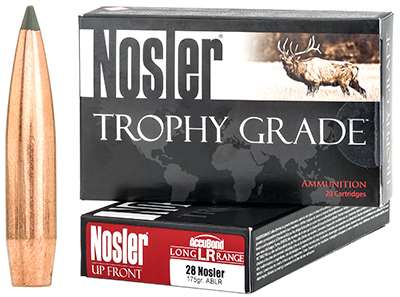
Unfortunately, continuing high demand for .26 Noslers (and other Nosler products and projects) slowed the availability of the .28 Nosler. Nosler sent its Patriot model to me for testing in the spring of 2015. The comparitively low price of the Patriot does not mean it’s an inferior rifle, since it uses the same Model 48 action and Pac-Nor barrel as other Nosler rifles, but unfortunately no factory ammunition was yet available, much less .28 Nosler cases or loading data.
The brass problem could have been solved by necking up some of the supply for my .26 Nosler rifle, but there really isn’t much point in working up loads without data, as traditional methods of “pressure guessing” have proven unreliable since very accurate piezoelectric equipment became the industry standard. There’s nothing as discouraging as a new hunting rifle in the safe with no ammunition to shoot. Late in summer, however, Nosler listed loading data on its website, and sent along 50 Match Grade brass cases, a set of RCBS dies and a box of 100 175-gr. AccuBond Long Range bullets. Since Nosler factory ammunition wasn’t then available, handloads would have to do.
There also happened to be a 3-10X 40 mm Nightforce SHV riflescope in the safe, ready for testing, but the only 30-mm rings in my rather large collection that combined well with the short-tubed SHV were Weaver Tip-Offs. They might be an unstylish accessorizing choice when connecting $3,000 of scope and rifle, but through the decades, Weaver’s “old uglies” have performed perfectly on many of my rifles, including a rather light .416 Rem. Mag. They worked fine on the .28 as well. As a side note, it’s normally not a good idea to mount an untested scope on a new rifle, because if anomalies occur it’s hard to tell whether the scope or rifle is at fault. But Nightforce scopes have proven so tough and reliable that an exception was made, and the scope worked perfectly throughout my testing.

All the propellants that Nosler’s data indicated should shoot most accurately were also on hand except for Alliant RL-33, since all but a few spoonfuls of my supply had been shot up testing the .26 Nosler. No RL-33 could be found locally, but the other propellants did very well.
Nosler’s load data included 150-, 160-, 168- and 175-gr. bullets, and the first range session served to sight-in the rifle and see its reaction to propellant charge weights slightly below the listed maximums. Aside from 175-gr. ABLRs, the bullets I tried included the 150-gr. Nosler Ballistic Tip (among the heavier-jacketed boattails, so a good choice in 7 mm magnums), 160-gr. Partitions, and another brand of 168-gr. target bullets with a much longer ogive than the Nosler Custom Competition used in Nosler’s testing. Unfortunately, it couldn’t be seated anywhere near the lands and still fit in the magazine—a situation I’ve encountered before with that bullet—and the one group I fired with it measured more than 4".

The three Nosler bullets all produced three-shot groups between 0.56" and 0.70" at 100 yds, with the smallest groups from 160-gr. Partitions. This may surprise some shooters but didn’t surprise me, as 6.5 mm 140-gr. Partitions are among the most accurate in my .26 Nosler, and have also shot very well in hundreds of other rifles.
Aside from the rifle and bullets, part of the accuracy was no doubt due to case uniformity. Nosler weight-sorts its cases, but I measured the neck thickness of all 50 cases and only a very few varied as much as 0.001". Since the case mouths of Nosler brass come already chamfered, no prepping was done except to run each neck over the expander ball in the sizing die.
None of the loads showed the slightest hint of excessive pressure, and a second range session with maximum listed powder charges indicated this rifle might have a little tighter barrel than the one used in Nosler’s tests, as velocities ran a little higher. In fact, the muzzle velocity with 160-gr. Partitions and Norma 217 ran more than 3400 f.p.s.! Bolt lift remained easy, but the velocity indicated pressure might be a little over 65,000 p.s.i., the SAAMI limit for the .28. Accuracy had also been a little better with slightly lighter loads, so the third range session used propellant charges approximately matching Nosler’s listed maximum velocities.
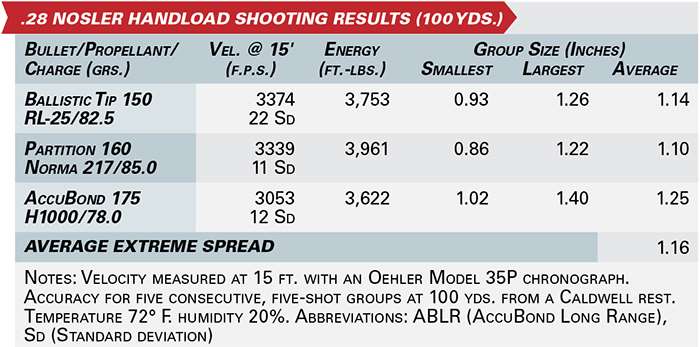
Here I should comment on the difference between the three-shot groups most hunters shoot today, and the five-shot groups required by the American Rifleman testing protocol. Most hunters believe (because they’ve been told so time and time again) that groups from sporter-weight barrels open up after three rounds, because the barrel starts to warp from accumulated heat. This can be true, but in reality five-shot groups from any rifle almost always average larger than three-shot groups, even a benchrest rifle capable of shooting groups only slightly larger than bullet diameter. This is due to the laws of chance, even if we wait five minutes between shots to allow our barrel to cool—which is often wasted waiting. Properly stress-relieved, sporter-weight barrels (not all are) will keep punching them in there, even when too hot to touch. The other common justification for three-shot groups is, “I almost never shoot more than three shots at any big-game animal,” but this has nothing to do with determining a rifle’s consistent level of accuracy. Most big-game animals don’t require half-inch groups at 100 yds., any more than a three-quarter-ton pickup with eight-ply off-road tires is required to haul a whitetail buck. But many of us insist on both the accuracy and the pickup.
Various statisticians have predicted how much larger five-shot groups will average over three-shot groups, but their answers have varied. In my experience derived from shooting a bunch of rifles, sometimes on indoor ranges where wind isn’t a factor, five-shot groups average about 1.5 times as large as three-shot groups, give or take. Nosler’s accuracy guarantees are for three-shot groups at 100 yds, and they’ll average about two-thirds the size as the five-shot averages listed in the range test data. And this is exactly what happened in this rifle, and in fact the dozen or so three-shot groups I fired all measured under an inch, sometimes approaching the magic half-inch.
The .28 Nosler does exhibit more recoil than most 7 mm magnums, about like a smaller .30-cal. magnum such as the .300 WSM. It also recoils more than the .26 Nosler, something I definitely noticed during the second range session when I sighted-in a new scope on my .26, also a Patriot, using 140-gr. handloads at around 3300 f.p.s. But with a firm grip and a PAST recoil pad strapped to my shoulder the .28’s comeback wasn’t uncomfortable, even when leaning into the rifle behind a benchrest. A popular computer recoil program calculated the final loads tested at 34.4 ft.-lbs. for the 150-gr., 37.1 for the 160 and 30.6 for the 175, numbers confirmed by my shoulder. The rifle weighed 9 lbs., 4 ozs. with the Nightforce, also dampening recoil.
It might seem odd for the 175-gr. load to recoil the least, but it used the lightest propellant charge and, unlike the 160-gr. load with Norma 217, muzzle velocity wasn’t exceptionally high. But the extremely high ballistic coefficient of the 175 ABLR provides more long-range oomph and less wind drift, and to many modern hunters that’s what “Big Sevens” are all about. (I also suspect the AccuBond Long Range would probably shoot more accurately after some fiddling with seating depth, a common tweak for secant-ogive bullets.)
Traditionalists who don’t shoot much beyond 400 yds., however, might prefer the 160 Partition, a well-proven bullet on big game from Alaska to Africa. Out to 400 yds. the 160 shoots a little flatter than the 175 ABLR and doesn’t drift significantly more in the wind. However, long-range hunters aren’t all that concerned about flat trajectory, since they’ll usually be twisting the elevation turret at longer ranges, and at 500 yds.the 175 starts to drift less. (To be fair, Nosler’s data lists muzzle velocities up to 3200 f.p.s. with the 175, but in this rifle lower velocity definitely resulted in finer accuracy.)
I didn’t test the Patriot at ranges beyond 100 yds., because in July at a joint writer tour hosted by Nosler and Leupold, I spent a large part of one day at a very long shooting range in central Oregon. Several of us got to shoot .28s with ABLR bullets out to 1,000-plus yds., and were very impressed, both in how it minimized wind drift and how hard it whacked steel way out there.
What’s next for Nosler’s case? The smart money would be on .30 caliber, but .338 might be a possibility. In the meantime, the .28 provides plenty of big-game performance in a reasonably packable package—and also a rebore possibility for .26 Nosler owners who eventually shoot out their rifles’ barrels. It might even out-sell the .26, because American hunters have always been more inclined toward 7 mm than 6.5 mm cartridges. Either way, Nosler’s parent case seems bound to sire an entire family of useful new cartridges.
